Winter 2004
The automation of discovery
Scientific revolutions are sometimes quiet. Despite a lack of public fanfare, there is mounting evidence that we are in the midst of such a revolution–premised on the automation of scientific discovery made possible by modern computers and new methods of acquiring data.
Consider, for example, the following developments:
- Using data from the 1970s, about eight years ago a team of data analysts working in Holland predicted that low-level lead exposure is more dangerous to children’s cognitive development than had previously been thought–a prediction confirmed by recent reanalyses of later observations;
- Using measurements of reflected solar energy (technically, the visible-near infrared spectrum), a computer identified minerals in rocks from a California desert lake as accurately as had a team of human experts at the site who had access both to the spectra and to the actual rocks; • In Antarctica, a robot traversing a field of ice and stones picked out the rare meteorites from among the many rocks; • Scientists at the Swedish Institute for Space Physics realized that an instrument aboard a satellite was malfunctioning and they recalibrated it from Earth;
- An economist working for the World Food Organization found that current foreign aid practices have no impact on extreme poverty;
- Climate researchers traced the global increase in vegetation and its causes over the last twenty years;
- A team of biologists and computer scientists reported determinations of the genes in yeast whose function is regulated by any of a hundred regulator genes;
- A kidney transplant surgeon measured the behavior of rat genes that had been aboard the space shuttle;
- A biologist reported a determination of (possibly) all of the human genes in . . .
